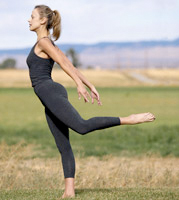
By Janet Smith, PEERtrainer Health and Fitness Writer

Yoga is often regarded as a gentle, stretching workout. While many types focus on deep poses and breathing, power yoga, aslo known as Ashtanga is anything but laid-back. This type of yoga packs a punch, combining the strengthening and stretching workout of traditional yoga classes with the added dynamic of an intense cardiovascular workout.
What is Power Yoga?
Power yoga is the westernized version of Ashtanga Vinyasa Yoga, an East Indian Yogic practice Ashtanga (power) yoga. Ashtanga Yoga poses are advanced with no rest between poses; each pose flows directly into the next. The postures are challenging and require a heavy dose of strength and balance.
What are the Benefits of Power Yoga?
Engaging in any yoga practice will benefit your overall health. Regular participation in yoga will help the participant to develop increased muscle strength and flexibility, resulting in reduced stress and body aches, and fewer injuries such as strains or sprains. Yoga can help alleviate of lower back pain. During a yoga session, you will practice deep breathing while holding poses. This deep breathing has been shown to decrease blood pressure, while increasing oxygenation to all parts of the body. Power yoga adds yet another benefit: a fat-burning, heart-strengthening cardiovascular component.
Who Can Practice Ashtanga?
Although power yoga offers a very challenging workout, and can be intense, the beauty of this type of yoga is its practice, to the individual. A good yoga instructor will encourage you to listen to your own body and go into poses only as deeply as you are comfortable. He or she may suggest specific modifications such as putting blocks under the hands if you are unable to reach the floor, or using an alternate pose where appropriate. Bryan Kest, the yoga teacher credited with first bringing Ashtanga yoga to America says this of the subject, “Power Yoga is directed at creating the highest level of energy, vitality and freedom. The only way to do this is to work with yourself, not against yourself.” Because yoga is low-impact, it is easy on joints and bones and perfect for people who are recovering from injuries. Any one, at any fitness level, can incorporate this practice into their fitness routine.